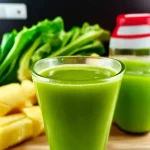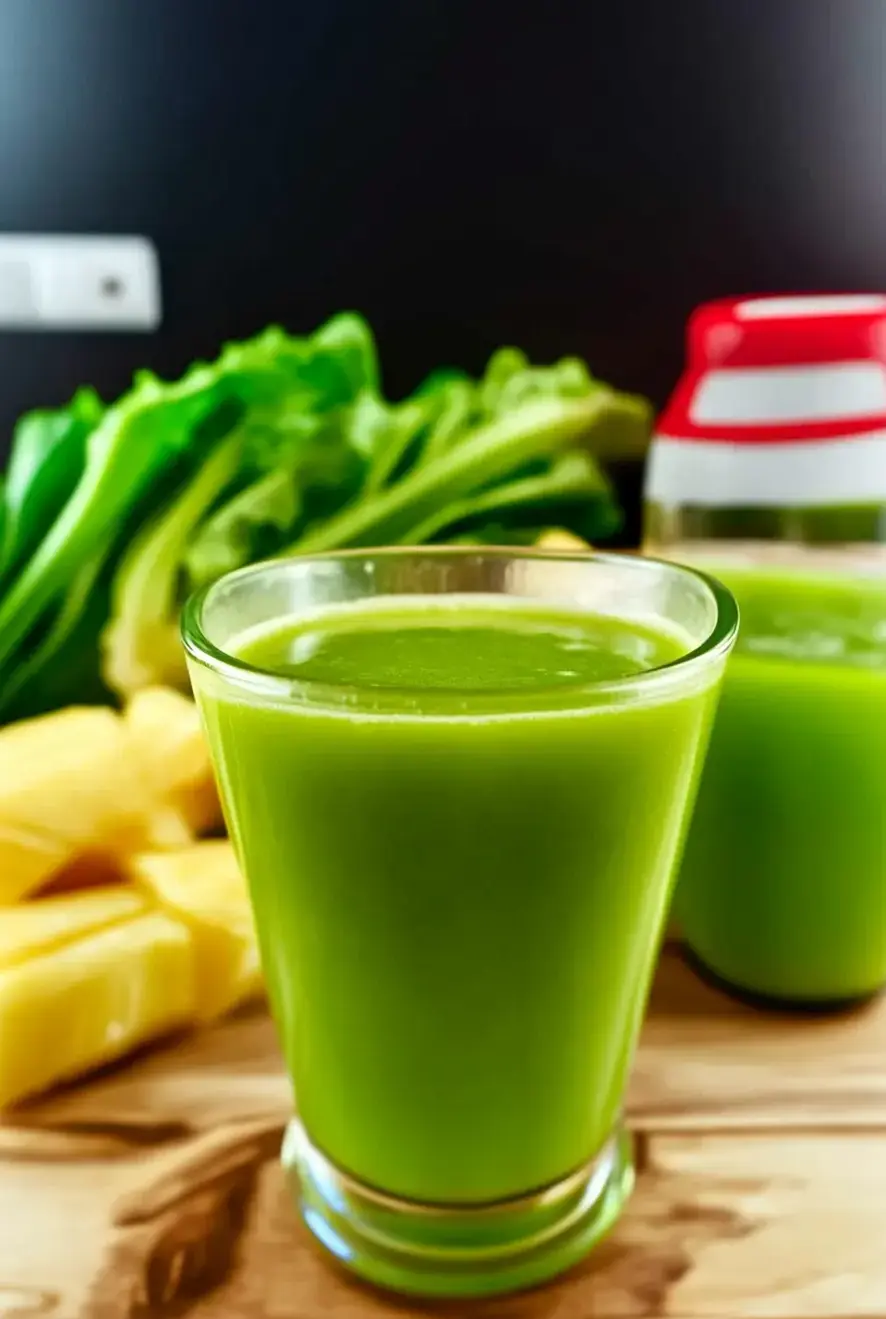Celery and Pineapple Juice is this amazing drink that I make when we want something refreshing and healthy. You could say it combines one of nature’s best detox vegetables with sweet tropical fruit. Its taste is surprisingly balanced – we get the crisp freshness from celery but also that sweet pineapple flavor. You then have this bright green juice that it has incredible health benefits like boosting digestion. Why do I love making this? We get tons of vitamins and minerals, but also it tastes so much better than store-bought versions.
Table of Contents
Why You’ll Love This Juice
This refreshing juice combination will quickly become a household favorite. The sweet pineapple perfectly balances the earthy, slightly salty taste of celery, creating a drink that’s both delicious and nutritious. You’ll get a powerful dose of vitamin C from the pineapple, plus anti-inflammatory compounds from the celery.
The apple adds natural sweetness while the ginger provides a subtle warming kick that enhances digestion. This juice is naturally hydrating and helps reduce bloating thanks to celery’s natural diuretic properties. Plus, it’s much more affordable than buying similar juices at health food stores. The vibrant green color makes it as appealing to look at as it is to drink.
Ingredients You’ll Need
- 1 pound fresh pineapple (approximately half a medium pineapple)
- 1 pound celery (approximately 4 large ribs)
- 1 medium Granny Smith apple, quartered with seeds removed
- ½ inch piece fresh ginger root
Choose ripe pineapple that gives slightly when pressed and has a sweet aroma at the base. The celery should be crisp with bright green leaves if still attached. Granny Smith apples work best because their tartness complements the other flavors without being too sweet. Fresh ginger should be firm and smooth-skinned – avoid pieces that look wrinkled or dried out.
Recommended Tools
A good quality juicer is essential for this recipe. Centrifugal juicers work well and are more budget-friendly, while masticating juicers extract more juice and nutrients but cost more. Either type will give you great results.
You’ll also need a sharp knife for cutting the pineapple and apple, plus a cutting board. A vegetable brush helps clean the celery thoroughly. Having a large glass or pitcher ready for the finished juice makes serving easier. Some people like to strain the juice through a fine-mesh sieve if they prefer it completely smooth, though this is optional.
How to Make Celery and Pineapple Juice
Start by washing all your produce thoroughly under cold running water. Use a vegetable brush to scrub the celery ribs, removing any dirt from the grooves. Pat everything dry with clean towels.
Cut the pineapple into spears or chunks that will fit through your juicer’s feed tube. Remove the tough outer skin and core, but don’t worry about getting every bit – your juicer will handle small pieces. The celery ribs usually fit through most juicers without cutting, but trim them if needed.
Quarter the apple and remove all seeds and the core. You can leave the skin on since it contains valuable nutrients and fiber.
Peel the ginger and cut it into small pieces that your juicer can handle easily.
Now comes the important part – juice in the right order. Start with the pineapple first, as it produces the most liquid and helps push the other ingredients through the machine. Follow with the apple pieces, then the ginger, and finish with the celery ribs.
The order matters because the pineapple’s high water content helps extract maximum juice from the drier ingredients like celery. The ginger goes in the middle so its strong flavor gets well distributed throughout the drink.
Once all ingredients are juiced, give the mixture a quick stir to combine all the flavors evenly. Taste and adjust if needed – you might want to add more apple for sweetness or more ginger for spice.
Tips For Best Results
Always juice the pineapple first to get the maximum liquid extraction. The pineapple juice helps push the fibrous celery through the machine more effectively.
Make sure your produce is at room temperature for better juice yield. Cold ingredients can be harder for the juicer to process efficiently.
Don’t throw away the pulp immediately – you can use celery pulp in vegetable soups or compost it for your garden. Pineapple pulp works great in smoothies or muffins.
Clean your juicer immediately after use to prevent pulp from drying and sticking to the parts. This makes cleanup much easier and keeps your machine in good condition.
If you find the juice too strong, add more apple. If it’s too sweet, increase the celery. The beauty of fresh juice is that you can adjust the ratios to your taste preferences.
How to Store Leftovers
Fresh Celery and Pineapple Juice tastes best when consumed immediately after making it. However, you can store it in the refrigerator for up to 24 hours in an airtight glass container. The juice will start to separate and lose some nutritional value after this time.
Before drinking stored juice, give it a good stir or shake since natural separation is normal. You might notice the color becomes slightly less vibrant, but this doesn’t affect the taste significantly.
For longer storage, you can freeze the juice in ice cube trays. These frozen juice cubes work great in smoothies or can be thawed for drinking later. Frozen juice maintains its nutrients for up to 3 months.
Never store fresh juice in metal containers, as this can affect the taste and potentially cause nutrient loss.
Variations to Try
Green Apple Celery Pineapple: Use green apples instead of red for a more tart flavor profile that complements the celery better.
Spicy Kick Version: Double the ginger amount and add a small piece of jalapeño for those who like heat in their drinks.
Cucumber Addition: Add one medium cucumber for extra hydration and a spa-like refreshing taste.
Lemon Twist: Add half a peeled lemon to brighten all the flavors and add extra vitamin C.
Mint Fresh: Juice a handful of fresh mint leaves with the other ingredients for a cooling, refreshing twist.
Turmeric Boost: Add a small piece of fresh turmeric root for anti-inflammatory benefits and a beautiful golden color.
Frequently Asked Questions
Can I make this juice without a juicer?
While a juicer gives the best results, you can use a high-powered blender as an alternative. Blend all ingredients with a small amount of water, then strain through cheesecloth or a fine-mesh sieve. The texture won’t be as smooth, and you’ll get less juice, but it still works. You could also try grating the ingredients finely and pressing them through a strainer, though this method is more labor-intensive.
How long does fresh celery and pineapple juice last?
Fresh juice is best consumed immediately but can be stored in the refrigerator for up to 24 hours in an airtight glass container. After this time, the juice starts losing nutrients and may develop an off taste. The natural enzymes in fresh juice are most active right after juicing, so drinking it quickly gives you maximum health benefits. If you notice any fizzing, sour smell, or color changes, discard the juice.
Can I substitute frozen pineapple for fresh?
Fresh pineapple works best for juicing because it has higher water content and produces more juice. Frozen pineapple can work, but thaw it completely first and expect less liquid yield. Frozen fruit also tends to make the juice slightly thicker and may affect the overall texture. If you do use frozen pineapple, let it come to room temperature before juicing for better results.

Celery and Pineapple Juice
- Total Time: 10 minutes
- Yield: 2 servings 1x
- Diet: Vegan
Ingredients
1 pound fresh pineapple (approximately half a medium pineapple)
1 pound celery (approximately 4 large ribs)
1 medium Granny Smith apple, quartered with seeds removed
½ inch piece fresh ginger root
Instructions
- Wash all produce thoroughly under cold running water.
- Use a vegetable brush to scrub celery ribs and remove dirt from grooves.
- Pat everything dry with clean towels.
- Cut pineapple into spears or chunks that fit your juicer.
- Remove the tough outer skin and core (small remaining bits are fine).
- Trim celery ribs only if necessary to fit into the juicer.
- Quarter the apple, remove seeds and core; leave the skin on for nutrients.
- Peel the ginger and cut into small, juicer-friendly pieces.
- Juice ingredients in the following order:
- Start with pineapple (produces the most liquid).
- Then add apple pieces.
- Follow with ginger (for even flavor distribution).
- Finish with celery (dryest ingredient).
- Stir the juice to combine all flavors evenly.
- Taste and adjust:
- Add more apple for sweetness.
- Add more ginger for extra spice.
Notes
- Juice the pineapple first to maximize liquid extraction and help push fibrous ingredients like celery through the juicer.
- Use room temperature produce for better juice yield and smoother juicing.
- Save the pulp: celery pulp can go into soups or compost; pineapple pulp is great in smoothies or muffins.
- Clean your juicer immediately after use to prevent dried pulp buildup and make cleanup easier.
- Adjust the juice to taste: add more apple if too strong, or more celery if too sweet.
- Prep Time: 10 minutes
- Cook Time: 0 minutes
- Category: Juice
- Method: Blending
- Cuisine: International
Nutrition
- Serving Size: 12 oz (355 ml)
- Calories: 80 kcal
- Sugar: 13 g
- Sodium: 75 mg
- Fat: 0.4 g
- Saturated Fat: 0 g
- Unsaturated Fat: 0.3 g
- Trans Fat: 0 g
- Carbohydrates: 20 g
- Fiber: 3 g
- Protein: 1.2 g
- Cholesterol: 0 mg

